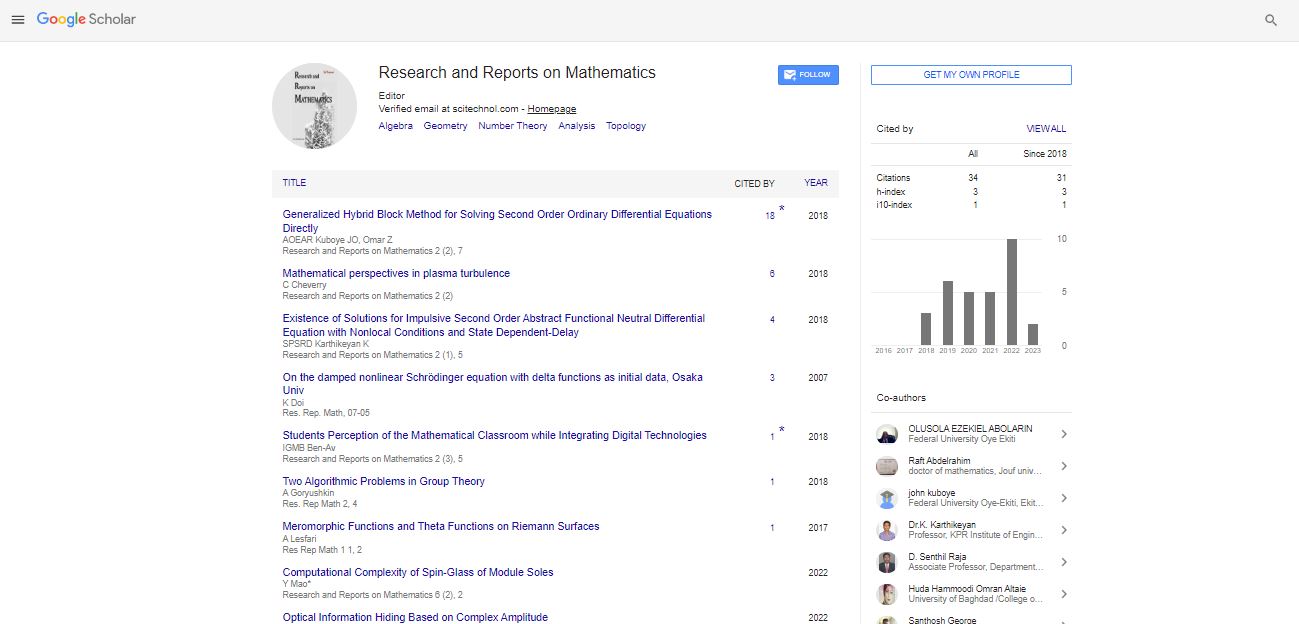Perspective, Res Rep Math Vol: 5 Issue: 11
The Geometry of Billiards in Ellipses (Ovals) and their Poncelet Lattices
Jimmie Lawson*
Department of Mathematics, Louisiana State University, Baton Rouge, LA, 70803, USA
*Corresponding Author:
Jimmie Lawson
Department of Mathematics, Louisiana State University, Baton Rouge, LA, 70803, USA
E-mail: lawson@math.lsu.edu
Received Date: November 09, 2021; Accepted Date: November 17, 2021; Published Date: November 24, 2021
Citation: Lawson J (2021) The Geometry of Billiards in Ellipses (Ovals) and their Poncelet Lattices. Res Rep Math 5:11. 136.
Copyright: © All articles published in Research and Reports on Mathematics are the property of SciTechnol, and is protected by copyright laws. Copyright © 2021, SciTechnol, All Rights Reserved.
Keywords: twobridge, distinct methodologies
Perspective
We calculate the character variations of several families of twobridge links, including the links b(2p,3), twisted Whitehead links, and double twist links. The number of irreducible components of such varieties is then determined using basic geometrical descriptions. Our research is inspired by Hilden, Lozano, and Montesinos’ excellent work on the character diversity of a class of 2-bridge connections, but it employs fundamentally distinct methodologies based on palindrome presentations of link groups. The resulting formulas for the following character variations are novel, easily programmed, and in many cases simpler than previously published equations.
The objective of this study is to investigate the geometry of billiards in ellipses using confocal central conic characteristics. The billiards’ extended sides come together at spots on confocal ellipses and hyperbolas. They define the Poncelet grid that is linked with them. If a billiard is periodic, it closes for any choice of the ellipse’s beginning vertex. This results in a continuous form of billiards known as billiard motion, despite the fact that it is neither Euclidean nor projective. When this motion is extended to the related Poncelet grid, new insights and invariants emerge.
By defining an equivalency with the three-dimensional hyperboloid model contained in four-dimensional Minkowski space, we show how the space SPD containing 2×2 positive definite Hermitian matrices of determinant 1 can serve as a model for spatial hyperbolic geometry. The new model expands hyperbolic geometry’s computational potential, while also providing geometric tools for matrix theory. Transferring concepts like centre of mass and centroid to the matrix setting and defining basic qualities they exhibit in that context is an example of the latter.
A Baer cone of PG(3,q2 ), q a prime power, is defined as a subset of points in the projective space intersected by any line in at least one point and by any plane in q2 +1, q2 +q+1 or q3 +q2 +1 points, according to Innamorati and Zuanni. We show in this study that a similar characterization applies even when the projective space’s order is not a square and the assumptions on the three intersection numbers with respect to the planes are weakened.
An interpretation surface in 3-layered Euclidean space is a surface that can be developed as the amount of two normal curves α and β. As of late, the negligible interpretation surfaces were described as far as the shape and the twist of the producing bends. In this paper, we describe all interpretation surfaces with consistent and non-zero mean curve by demonstrating that: The main interpretation surface in 3-layered Euclidean space R3 with steady and non-zero mean shape H is the circular cylinder of radius 1/2|H|.
It is realized that negligible surfaces in Euclidean space can be addressed as far as holomorphic capacities. For instance, we have the notable Weierstrass portrayal, where part of the holomorphic information is picked to be the stereographic projection of the typical of the relating surface, and furthermore the Björling representation, where it is recommended a curve on a superficial level and the unit ordinary on this curve. In this work, we are keen on the holomorphic representation of negligible surfaces in essentially isotropic space, a three-layered space outfitted with a position 2 measurement of file zero. Since the isotropic metric is degenerate, a surface ordinary can’t be unequivocally characterized in view of metric properties just, which prompts particular meanings of an isotropic typical. As a result, this may likewise prompt unmistakable types of a Weierstrass and of a Björling portrayal. Here, we tell the best way to address basically isotropic negligible surfaces as per the decision of an isotropic surface ordinary
 Spanish
Spanish  Chinese
Chinese  Russian
Russian  German
German  French
French  Japanese
Japanese  Portuguese
Portuguese  Hindi
Hindi 